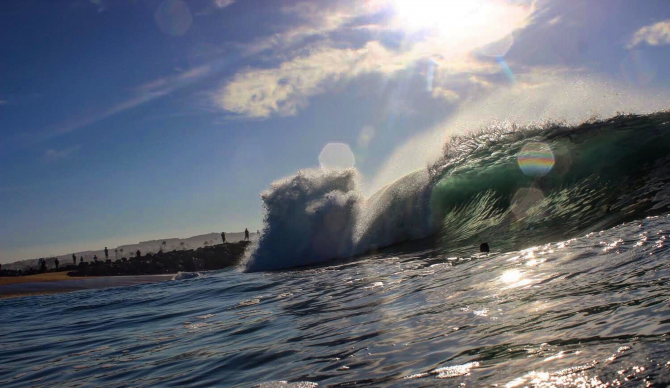
The Wedge of Newport Beach, credit: Mark Stansbury
There’s a juxtaposition between the outdoor sports we love and the footprint they create. The natural landscapes are what lure us in — the perfect reef that creates a perfect wave or a mountain peak that creates the optimal conditions for skiing or snowboarding. Though we love traveling to The North Shore, The Alps, and other paradises of the world, the increased traffic it all creates through tourism also creates a greater footprint. Ironically, many materials we use for our outdoor clothing, boards, and gear can have harmful effects on the environment and even our own human health and ecosystem. We as consumers can be more aware of how we use these products and have a better understanding of how to conserve in the future. Sustainability has become a buzzword in action sports, but some of these companies known to be the most sustainable are still using toxic chemicals in their manufacturing processes.
Forever Chemicals in Action Sports
PFAS, or per-and polyfluoroalkyl substances, are “forever chemicals” that persist in the environment and do not decompose in nature. Because these chemicals are weatherproof and stain-resistant, they’re a useful material in outdoor gear. The most common uses of PFAS in these materials include ski and snowboard jackets, bags, some surf waxes, ski waxes, sandals, sunscreen, and even boardshorts and bikinis. The American Chemical Society analyzed wax and repair professionals in the ski and snowboard industry and found them to contain 25 times the amount of PFAS compared to that of the average adult.
PFAS can be detected in 98 percent of Americans’ blood today and prolonged exposure to them has been linked to kidney cancer, testicular cancer, decreased fertility, thyroid disease, liver damage, and more. The Natural Resource Defense Council has outlined PFAS pollution and the effects on our health and is urging major retail manufacturers to migrate out of using these products. It’s not just the outdoor industry as these materials are in a lot of products we as consumers purchase, including non-stick cookware, carpeting, clothing, takeout food packaging, cleaning products, and even cosmetics. The U.S. House of Representatives currently has a bill on the floor to regulate PFAS levels in drinking water and wastewater, an essential move toward stopping businesses from polluting PFAS into our atmosphere.
What Can We Do?
Consumers have the most power in the supply chain. Some activists are protesting some of our favorite outdoor retailers until they address this environmental and public health crisis. And the most important thing we can do is research before we buy. PFAS can be disguised on labels with euphemisms like weatherproof, durable water repellent, fluorochemicals, stain-resistant, PFOS, PFOA, PFNA, PFHxS, PFHxA, PFDA, PFBS, and PFCs.
Many retailers even mention PFAS or forever chemicals on their website and in their sustainability plans. Look into alternative products such as waxes that have zero toxins/paraffins and use all organic ingredients. And when you leave the beach, it’s very important to ensure you’re not leaving behind items like sandals, chairs, sunscreen, takeout food containers, and water bottles.
Challenge Current Waste Treatment Methods
The surf industry’s approach to this problem thus far has been to better recycle materials for reuse. It is an admirable mission but it still circulates these materials back into circulation. With plastic production set to double by 2030, our ultimate goal should look toward the destruction of these materials with less burden on our oceans, lakes, and rivers. The current methods of treating water, especially PFAS, are not sufficient. A common waste treatment method for PFAS is incineration, which pollutes our air quality. There’s also anaerobic digestion, which uses microorganisms in the lack of oxygen to break these compounds down into smaller, short-chain PFAS compounds and then release them back into the atmosphere through our fertilizer. These methods are not entirely effective at eliminating PFAS as they still spread contamination back into our crops and groundwater. Desalination is another method that’s been debated as outlined in Huntington Beach. The determination there was it would create more brine, pollution, and salt content back into the ocean which is affecting sea life.
While other water treatment methods attempt to separate PFAS from water, a process called supercritical water oxidation has found great success in actually destroying these molecules. It’s a physical-thermal process when water is raised to a high temperature and pressure similar to a large pressure cooker, it breaks down long-chain carbon-fluorine bonds found in PFAS and turns it back into clean water and reusable minerals. Where other methods separate PFAS, this method destroys it along with other toxins like plastic and even pharmaceuticals. A cleantech mastered by Dr. Marc Deshusses, Professor of Civil Engineering at Duke University and Co-Founder of startup 374Water in partnership with the Bill & Melinda Gates Foundation.
Creating Societal Change
Innovative technologies and new alternatives to harmful products help us move forward and limit our impact on the oceans, mountains, and environment. Look into PETA’s list of Vegan Surf Waxes free of chemicals harmful to the environment. There are so many alternatives to accepting PFAS into our everyday lives. But our biggest influence lies in calling on our favorite brands to make a drastic change in what materials they use and how they process their waste and wastewater. We can also challenge governments, municipal leads, and businesses alike to properly dispose of PFAS and other harmful contaminants by deploying clean technologies in wastewater. But if we as a society continue to pollute our favorite beaches, mountains, and landscapes without acknowledging the impact, it’s simply unsustainable.

